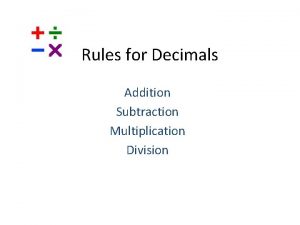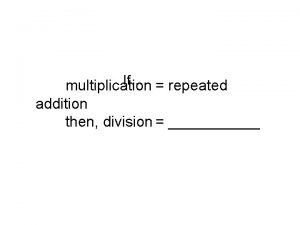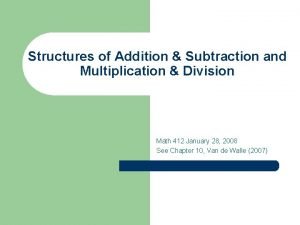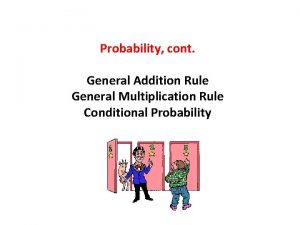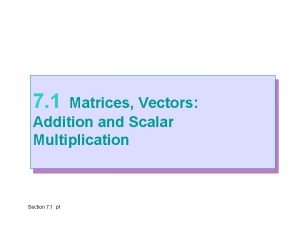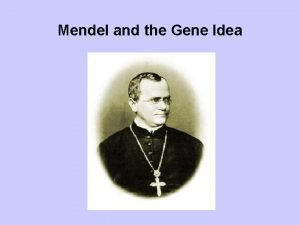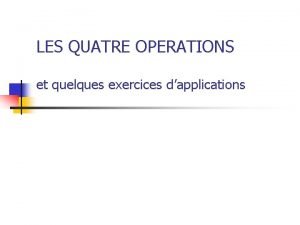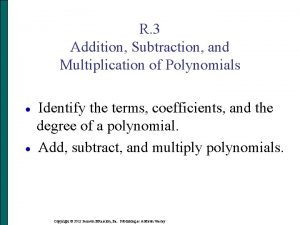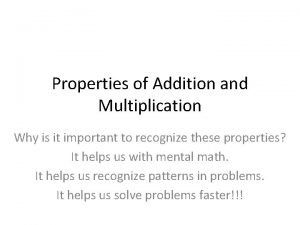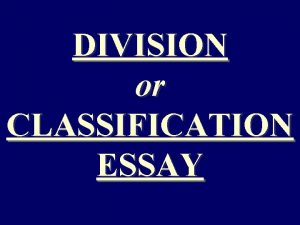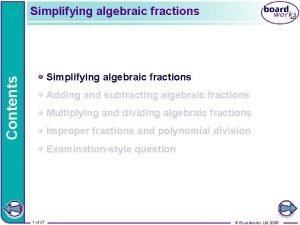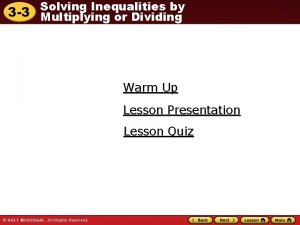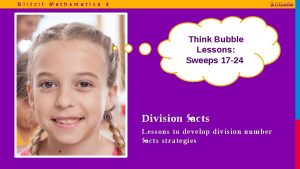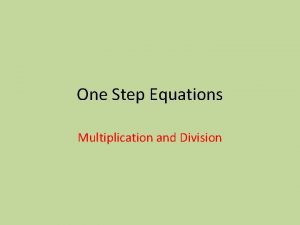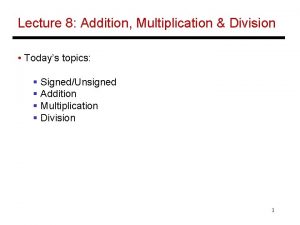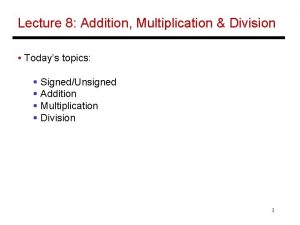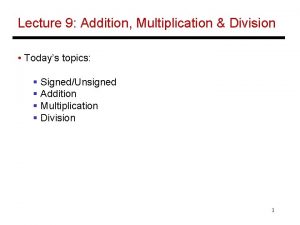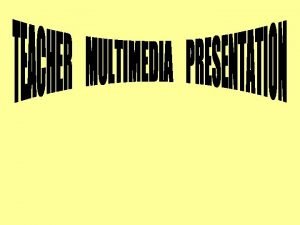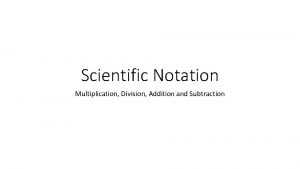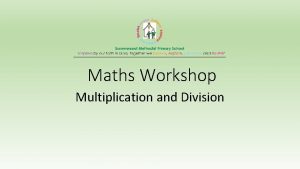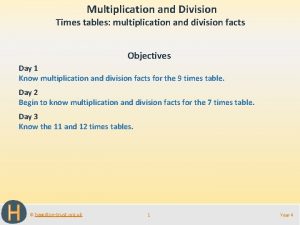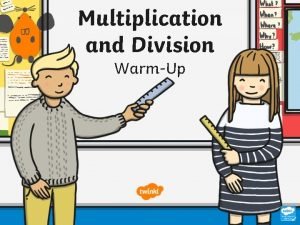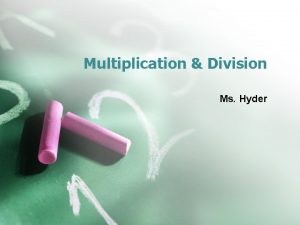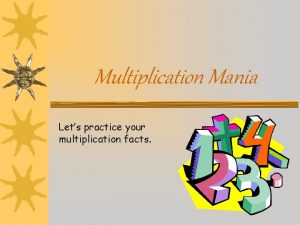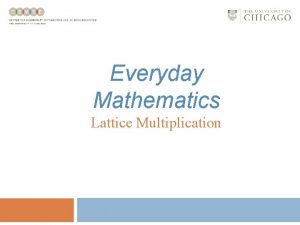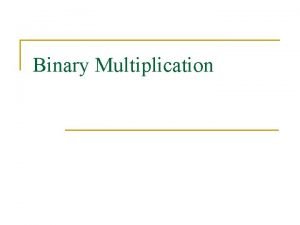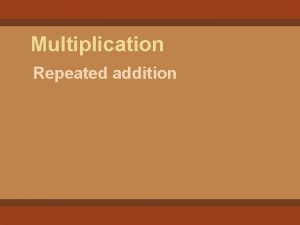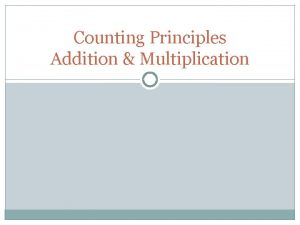Lecture 8 Addition Multiplication Division Todays topics SignedUnsigned



















- Slides: 19

Lecture 8: Addition, Multiplication & Division • Today’s topics: § Signed/Unsigned § Addition § Multiplication § Division 1

Signed / Unsigned • The hardware recognizes two formats: unsigned (corresponding to the C declaration unsigned int) -- all numbers are positive, a 1 in the most significant bit just means it is a really large number signed (C declaration is signed int or just int) -- numbers can be +/- , a 1 in the MSB means the number is negative This distinction enables us to represent twice as many numbers when we’re sure that we don’t need negatives 2

MIPS Instructions Consider a comparison instruction: slt $t 0, $t 1, $zero and $t 1 contains the 32 -bit number 1111 01… 01 What gets stored in $t 0? 3

MIPS Instructions Consider a comparison instruction: slt $t 0, $t 1, $zero and $t 1 contains the 32 -bit number 1111 01… 01 What gets stored in $t 0? The result depends on whether $t 1 is a signed or unsigned number – the compiler/programmer must track this and accordingly use either slt or sltu slt $t 0, $t 1, $zero sltu $t 0, $t 1, $zero stores 1 in $t 0 stores 0 in $t 0 4

Sign Extension • Occasionally, 16 -bit signed numbers must be converted into 32 -bit signed numbers – for example, when doing an add with an immediate operand • The conversion is simple: take the most significant bit and use it to fill up the additional bits on the left – known as sign extension So 210 goes from 0000 0010 to 0000 0000 0010 and -210 goes from 1111 1110 to 1111 1111 1110 5

Alternative Representations • The following two (intuitive) representations were discarded because they required additional conversion steps before arithmetic could be performed on the numbers § sign-and-magnitude: the most significant bit represents +/- and the remaining bits express the magnitude § one’s complement: -x is represented by inverting all the bits of x Both representations above suffer from two zeroes 6

Addition and Subtraction • Addition is similar to decimal arithmetic • For subtraction, simply add the negative number – hence, subtract A-B involves negating B’s bits, adding 1 and A Source: H&P textbook 7

Overflows • For an unsigned number, overflow happens when the last carry (1) cannot be accommodated • For a signed number, overflow happens when the most significant bit is not the same as every bit to its left § when the sum of two positive numbers is a negative result § when the sum of two negative numbers is a positive result § The sum of a positive and negative number will never overflow • MIPS allows addu and subu instructions that work with unsigned integers and never flag an overflow – to detect the overflow, other instructions will have to be executed 8

Multiplication Example Multiplicand Multiplier Product 1000 ten x 1001 ten -------1000 0000 1000 --------1001000 ten In every step • multiplicand is shifted • next bit of multiplier is examined (also a shifting step) • if this bit is 1, shifted multiplicand is added to the product 9

HW Algorithm 1 Source: H&P textbook In every step • multiplicand is shifted • next bit of multiplier is examined (also a shifting step) • if this bit is 1, shifted multiplicand is added to the product 10

HW Algorithm 2 Source: H&P textbook • 32 -bit ALU and multiplicand is untouched • the sum keeps shifting right • at every step, number of bits in product + multiplier = 64, hence, they share a single 64 -bit register 11

Notes • The previous algorithm also works for signed numbers (negative numbers in 2’s complement form) • We can also convert negative numbers to positive, multiply the magnitudes, and convert to negative if signs disagree • The product of two 32 -bit numbers can be a 64 -bit number -- hence, in MIPS, the product is saved in two 32 -bit registers 12

MIPS Instructions mult $s 2, $s 3 computes the product and stores it in two “internal” registers that can be referred to as hi and lo mfhi mflo $s 0 $s 1 moves the value in hi into $s 0 moves the value in lo into $s 1 Similarly for multu 13

Fast Algorithm • The previous algorithm requires a clock to ensure that the earlier addition has completed before shifting • This algorithm can quickly set up most inputs – it then has to wait for the result of each add to propagate down – faster because no clock is involved -- Note: high transistor cost 14 Source: H&P textbook

Division Divisor 1000 ten | 1001 ten 1001010 ten -1000 10 1010 -1000 10 ten Quotient Dividend Remainder At every step, • shift divisor right and compare it with current dividend • if divisor is larger, shift 0 as the next bit of the quotient • if divisor is smaller, subtract to get new dividend and shift 1 as the next bit of the quotient 15

Division Divisor 1000 ten | 1001 ten 1001010 ten Quotient Dividend 0001001010 0000001010 1000000 000100000010000001000 Quo: 0 000001001 At every step, • shift divisor right and compare it with current dividend • if divisor is larger, shift 0 as the next bit of the quotient • if divisor is smaller, subtract to get new dividend and shift 1 as the next bit of the quotient 16

Divide Example • Divide 7 ten (0000 0111 two) by 2 ten (0010 two) Iter 0 Step Quot Divisor Remainder Initial values 1 2 3 4 5 17

Divide Example • Divide 7 ten (0000 0111 two) by 2 ten (0010 two) Iter Step Quot Divisor Remainder 0 Initial values 0000 0010 0000 0111 1 Rem = Rem – Div Rem < 0 +Div, shift 0 into Q Shift Div right 0000 0010 0000 0001 0000 1110 0111 0000 0111 2 Same steps as 1 0000 0001 0000 1000 1111 0000 0111 3 Same steps as 1 0000 0100 0000 0111 4 Rem = Rem – Div Rem >= 0 shift 1 into Q Shift Div right 0000 0001 0000 0100 0000 0010 0000 0011 5 Same steps as 4 0011 0000 0001 18

Title • Bullet 19
 Rules in adding decimals
Rules in adding decimals Division is repeated addition
Division is repeated addition Arithmetic addition subtraction multiplication division
Arithmetic addition subtraction multiplication division Multiplication doc.com
Multiplication doc.com Principles of multiplication
Principles of multiplication Addition multiplication rule
Addition multiplication rule Skew matrix example
Skew matrix example Multiplication and addition rule genetics
Multiplication and addition rule genetics Multiplication ou addition prioritaire
Multiplication ou addition prioritaire Addition subtraction and multiplication of polynomials
Addition subtraction and multiplication of polynomials Inverse property of addition and multiplication
Inverse property of addition and multiplication 01:640:244 lecture notes - lecture 15: plat, idah, farad
01:640:244 lecture notes - lecture 15: plat, idah, farad Division and classification essay examples
Division and classification essay examples Proper algebraic fraction
Proper algebraic fraction Dividing scientific notation worksheet
Dividing scientific notation worksheet 3-3 solving inequalities by multiplication or division
3-3 solving inequalities by multiplication or division Parts of a multiplication equation
Parts of a multiplication equation Jeopardy multiplication
Jeopardy multiplication Multiplication facts and division facts
Multiplication facts and division facts One step division equations
One step division equations
